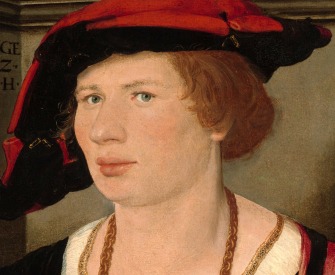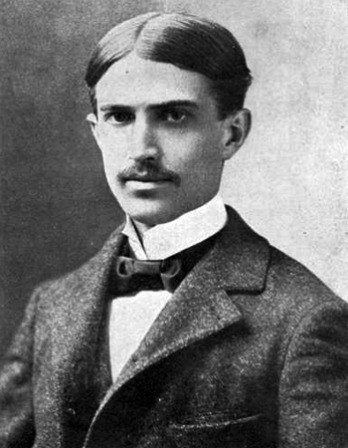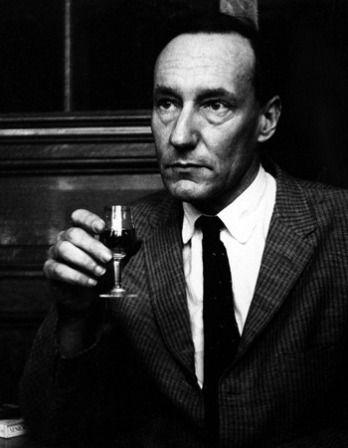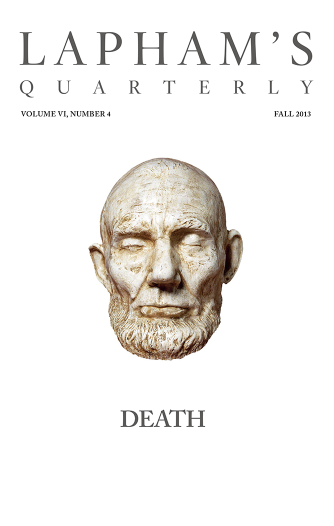Play, wherein persons of condition, especially ladies, waste so much of their time, is a plain instance to me that men cannot be perfectly idle; they must be doing something, for how else could they sit so many hours toiling at that which generally gives more vexation than delight to people whilst they are actually engaged in it?
—John Locke, 1693Wordplay
Sportswriting is a language rich in slang that’s helped create our common culture.
By Simon Apter

It’s a minor-league mind that chooses to make sport of sports. Not that there aren’t major-league authors who do so, among them George Orwell (“Serious sport is war minus the shooting”) and H.L. Mencken (“It is impossible to imagine Goethe or Beethoven being good at billiards or golf”). Their thinking hurts the ball club. As a nation, it is through the prism of sports that we frame our ethical values, remember our history, envision our future, and find the figures of speech that create our common culture and define our national identity.
Walt Whitman once whimsically described American democracy as “athletic”; history has borne out his observation in more ways than he could have foreseen.
Even the most effete and non-sports-minded Washington policy wonk has referred to a certain political candidate as a “dark horse,” asked whether or not to “cut and run” from the Iraqi desert. An abusive, anachronistic husband doesn’t have to play cribbage to “take his wife down a peg,” and a cockamamie idea need not be born in a ballpark to come “straight out of left field.” Because we are always playing, competing, scorekeeping—a game always in progress somewhere, at the arena or onscreen, live-blogged or streamed to an iPhone—the turns of phrase come as confidently and fluently to mind as did the Latin tags and Biblical verses that once furnished the infield chatter of eighteenth-century statesmen and nineteenth-century preachers. We decide elections by means of a race, champion sexual conquests as scores, characterize self-inflicted blunders as fumbles. A faux pas is off-base, and a second-rate talent is a jabroni (a lexical gift from professional wrestling). The failure to pick up a lady at a bar—a loss of esteem if not of a match or a round—is a strikeout, even though it doesn’t preclude one from immediately stepping up to the plate again and taking another swing (advisedly, against a different pitcher). A salesman’s last-ditch attempt to close the deal, to pull a win from the tomb of defeat, is a Hail Mary pass. And during moments of confusion and doubt, we take comfort in the story line of the noble underdog, trusting that from the “real world” of our depression, hopelessness, and “wait till next year” defeatism, we can depend for rescue on the Dream Team or Cinderella Man.
Our infatuation with the come-from-behind victory draws from the optimism and enthusiasm of Walt Whitman, who, ostensibly, as America’s first modern sportswriter, thought real life a substitution, albeit a poor one, for sports. As extravagant in his rhetoric as Grantland Rice or Red Smith, Whitman grasped the “rah-rah” quality of sports and found something inherently American in the unfettered boosterism of fandom. “The hurrah game!” he said of baseball to Horace Traubel in 1889.
Well—it’s our game: that’s the chief fact in connection with it: America’s game: has the snap, go, fling, of the American atmosphere—belongs as much to our institutions, fits into them as significantly, as our constitutions, laws: is just as important in the sum total of our historic life.
Where Mencken scoffs, Whitman applauds, his effervescence opening the door for a nation to be transformed—transfixed, really—into a culture of literate, if not literary, fans. Whitman’s words about temporal action on the field prepared the ground for permanent memories in the mind, the after-the-fact account of the action, allowing the joy of the game to transcend time and insinuate itself into history.
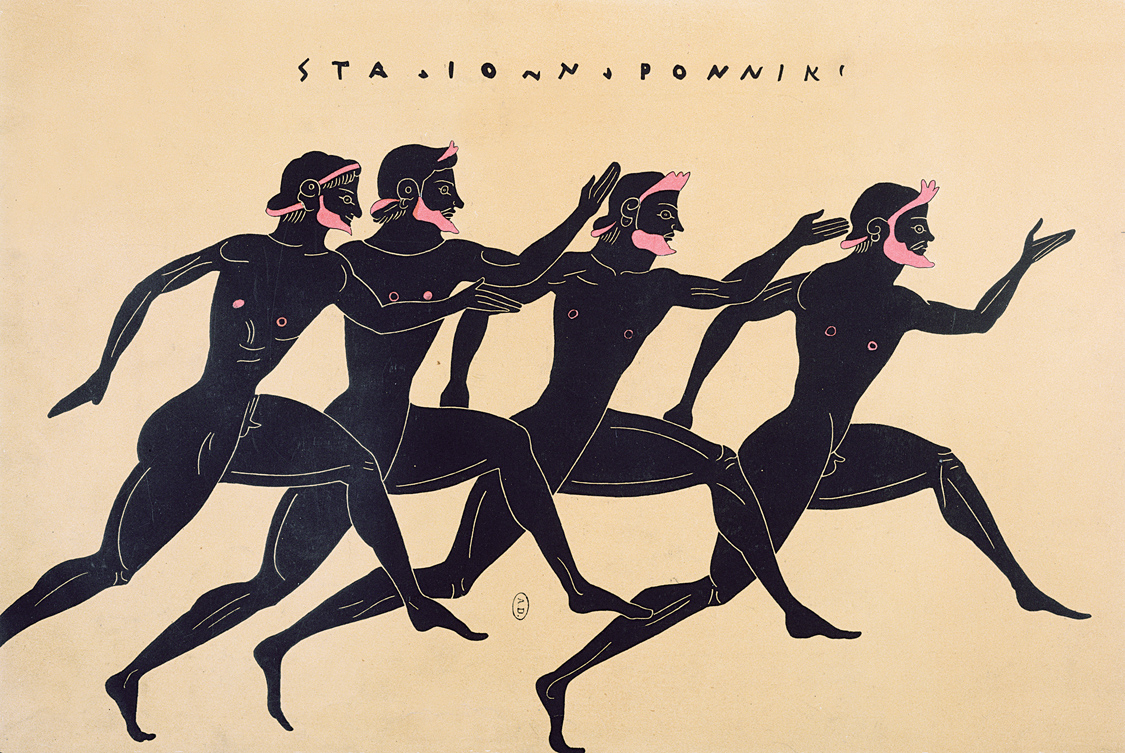
Athletes in a footrace, French lithograph after an ancient Greek vase, c. 1850. © Bibliotheque des Arts Decoratifs, Paris/Archives Charmet/The Bridgeman Art Library International.
By the 1890s, Whitman’s vision had been absorbed and digested by newspaper publishers. As part of its circulation battle with William Randolph Hearst’s New York Journal, Joseph Pulitzer’s New York World had in 1883 established the first separate sports section in any New York daily newspaper. In Chicago in 1887, the Evening News had begun augmenting its reporting of baseball scores with actual accounts of the games. These were written by Finley Peter Dunne, a writer who unapologetically tailored his coverage to appeal to the mass market. The Chicago Daily News sought to distinguish itself from the higher-brow Tribune by heavily investing itself in coverage of sports; the paper’s hack poet—and passionate baseball fan—Eugene Field found himself the highest paid writer in the city. Sports journalism offered the public something new, something fresh. Turn-of-the-century journalists were inventing an appropriate language to describe athletic contests as quickly as they could write it. Fanciful sports coverage soon became the surest path to higher circulation; editors and publishers began sending their best reporters to cover games.
“Sports reporting,” sociologist Hugh Dalziel Duncan notes in a discussion of Chicago’s turn-of-the-century newspaper culture,
became highly inventive, and its language rich in slang and new turns of phrase. By 1920 a very large part of current American slang was propagated by the newspapers, and much of it was invented by newspaper writers, as we know from the development of baseball slang...The inventiveness of sportswriters was so great that connoisseurship soon developed; a skilled slang maker soon became a local hero of the press and the reading public, somewhat after the fashion of the village swearer whose profanity moved the ungodly to admiration.
Duncan goes on to credit American newsmen with the creation of “an indigenous American urban language,” the perfect medium for conveying the passion that Whitman had discovered. And so sportswriting became something of an incubator for American neologism and a laboratory for verbal experimentation. Beyond this, though, early American sportswriters were playing around with nuance, juxtaposing the solemnity of scripture with the sweat of sport.
In the fall of 1924, writer Grantland Rice looked to scripture (with no undue sense of hyperbole) to find an apt description for the offensive backfield of the University of Notre Dame football team. Famously, after the Fighting Irish defeated Army at the Polo Grounds in New York City, Rice preached a sermon in the pulpit of the New York Herald Tribune:
Outlined against a blue-gray October sky, the Four Horsemen rode again. In dramatic lore they are know as Famine, Pestilence, Destruction, and Death. These are only aliases. Their real names are Stuhldreher, Miller, Crowley, and Layden. They formed the crest of the South Bend cyclone before which another fighting Army football team was swept over the precipice at the Polo Grounds yesterday afternoon as 55,000 spectators peered down on the bewildering panorama spread on the green plain below.
The ebullience feels overwrought in the twenty-first century, but “Granny” Rice, was simply carrying on the torch of Whitman, telling stories that would become part of a collective American memory. Sportswriters like Rice, writes David Maraniss, Pulitzer Prize–winning biographer of Vince Lombardi, “served as the nation’s tribe of storytellers, popular artists invested with enormous powers to reinforce cultural mores and shape the public imagination.” Rice and his contemporaries—including the New York American’s Damon Runyon, who in his “Both Barrels” column filed whimsical reports of games as if he were writing a telegram home to his grandmother—were mythmaking, recasting goal-line stands at the Polo Grounds as pivotal moments in history, bloody and mud-caked men as demigods. The great Vince Lombardi owes much of his immortality to writer Tim Cohane, a classmate of his at Fordham, who after serving in the Bronx as PR man for the school’s team, the Rams, eventually became the sports editor at Look Magazine and a Vince Lombardi champion to anyone who’d read or listen.
An apotheosis of sorts occurred on October 3, 1951, at 3:58 p.m., when New York Giants third baseman Bobby Thomson smashed the “shot heard round the world” off Brooklyn Dodgers pitcher Ralph Branca in the bottom of the ninth inning in the final game of the National League Playoff series. It is still the most famous moment in the history of baseball. “I don’t believe it!” radio announcer Russ Hodges yelled into his microphone as Thomson circled the bases. “I don’t believe it! I do not believe it!” “How in the hell do you write this story?” the Daily News’ Jim McCulley asked a colleague shortly after the game. Not even word from Washington that the Soviet Union had just detonated an atomic bomb could top the sportswriters’ enthusiasm over Thomson’s homer. Reported The New York Post, “Any repercussions of the atomic disclosure were firmly overshadowed by a thunderous noise that…was registered at 3:58 p.m.” And the Newark Star-Ledger printed its “Giants Do It, 5–4!” headline above the more somber, but evidently less important, “Russia Explodes 2D A-Bomb.”
Legendary New York Herald Tribune sportswriter Red Smith knew to frame his account of the shot as a farewell to straight-up, nonmelodramatic reportage:
Now it is done. Now the story ends. And there is no way to tell it. The art of fiction is dead. Reality has strangled invention. Only the utterly impossible, the inexpressibly fantastic, can ever be plausible again.
O ne can only wonder, then, how Smith, one of Muhammad Ali’s most intolerant critics, would have felt about the perfect sportswriting storm that gathered around the Greatest at his 1974 fight against George Foreman in Kinshasa, Zaire. Ali, of course, was a walking superlative, a man capable of spawning legend simply by existing. Gallingly, he seemed to have taken his triumphant, “only in America” biography and thrown it back in the nation’s face, an act of defiance for which liberals loved him and conservatives loathed him. Still, seven years after he had refused conscription into the U.S. Army and had his World Heavyweight Championship taken from him, he had implausibly come to Africa to solidify his role as America’s comeback kid. Against a Foreman seven years his junior in the so-called Rumble in the Jungle, Ali was a 3-to-1 underdog.
In Kinshasa, Ali had his usual coterie with him. There was trainer Angelo Dundee, the leader in the corner who had been with Ali since he’d come up as Cassius Clay—the “Louisville Lip”—in the early ’60s; Ferdie Pacheco, Ali’s fight doctor and personal physician; and ubiquitous cornerman Drew Bundini Brown, the rhymer, riddler, and sometime junkie who believed that when he bestowed upon Ali his supernatural “voodoo,” victory was inevitable. But there were other, unofficial cornermen there, too, talented figures who worked with voodoo more powerful than even Bundini’s.
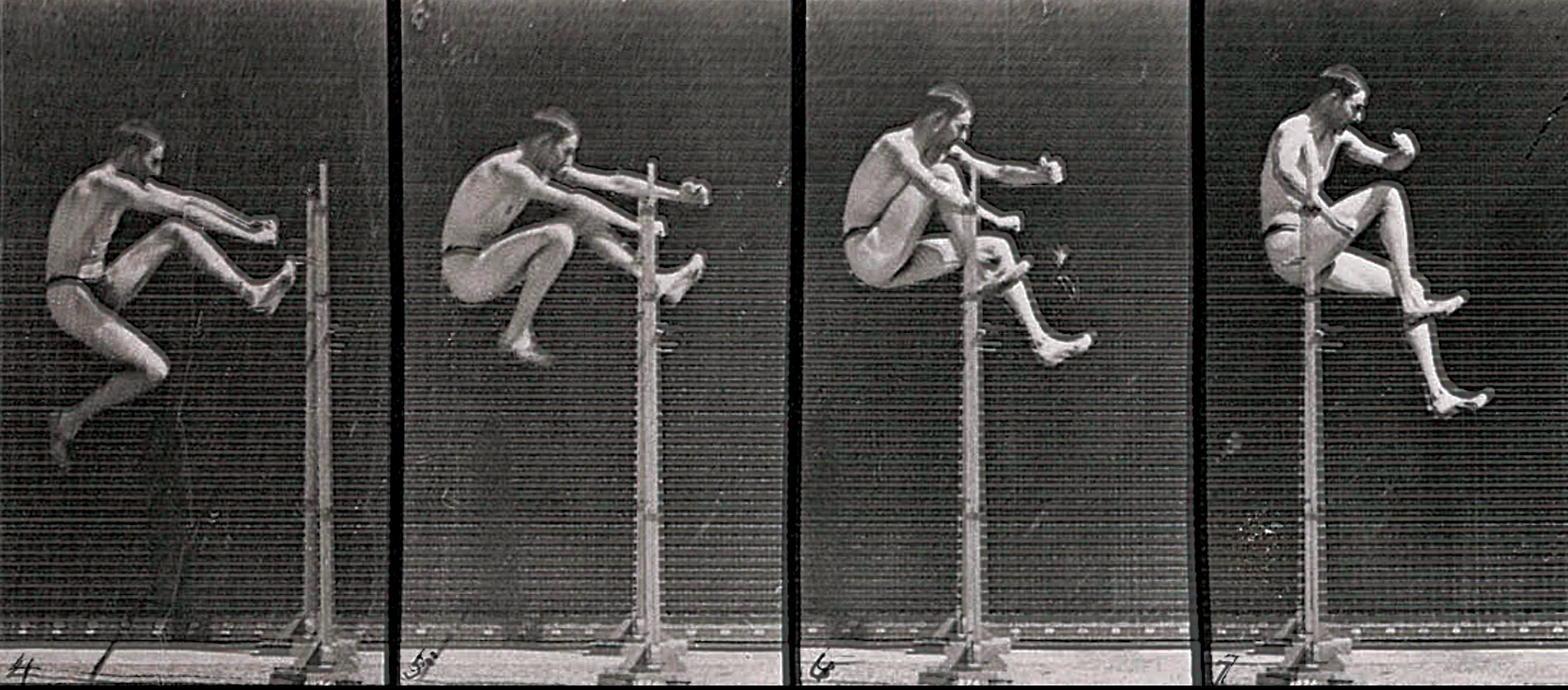
Man jumping, time-lapse photographs from the Animal Locomotion series, by Eadweard Muybridge, c. 1885. The Wellcome Trust, London.
Famously, George Plimpton, representing Sports Illustrated, and Norman Mailer, for Esquire, sat ringside at the October 30 fight. Rolling Stone had sent Hunter S. Thompson to Zaire as well, but the predawn scheduling of the bout precluded him from actually attending the fight (and from filing a story). During the fight he was seen floating in the pool, bottle in hand, at the Intercontinental Hotel. But one MIA writer notwithstanding, Plimpton’s, Mailer’s, and Thompson’s presences in Kinshasa were telling. Three of America’s most famous writers had descended upon the city for a story that had the potential to be a once-in-a-generation yarn, a quintessentially American tale that would transcend boxing, sports, maybe even history, a mythical moment in the league with the ’51 Dodgers-Giants playoff or the ’24 Notre Dame-Army matchup. True, there were the 1974 midterm elections to be held just six days after the fight, and America’s first post-Nixon polls were bound to make for influential and intriguing theater—but the real story that fall, the real event on everyone’s mind, would unfold on the banks of the Zaire River, not the Potomac. President Ford had controversially pardoned Nixon seven weeks before the bout, the nation still reeled from political scandal, but if Ali could beat Foreman, he might restore pride to the nation and complete one of the greatest comebacks in American history: from convicted draft dodger and bankrupted pariah to heavyweight hero, his criminal record removed by the Supreme Court, his historical legacy preserved by America’s sportswriting intelligentsia. Like him or not, the country would once again be represented by something called “the Greatest.”
About two and a half minutes into round eight, Ali obliged, sending a weary Foreman to the canvas with a devastating combination of punches. SI’s Plimpton, naturally, didn’t disappoint. The consummate sportswriter, a descendant of Whitman and Rice and Smith, he knew what was good for the ball club. “Kinshasa,” he wrote in his cover story,
is a city symbolically appropriate to the fall and shifts of dominance and power. Everywhere, usually at the end of a broad avenue, or in front of a government building, are great, bare stone pedestals, now flat on top, with weeds growing in the cracks, on which once stood the imposing statues of Belgian colonial rule. On the promontory above the stretch of the Zaire which is still called Stanley’s Pool, the famous statue of the explorer himself once stood, peering up the river under the palm of one hand like an Indian chief. It too has been pulled down and lies in a giant shed near the National Museum in a jumble of cast-iron horses and kings. The roof of the shed is tin. On the dawn of the day the heavyweight crown shifted hands, the sound of the rain on the roof must have been deafening.
Plimpton reminds us that our national spirit is alive and well, that any fissures and corrosion caused by the realities of economics, psychology, or politics can be papered over by our tried-and-true mythography. It’s thick with sentimentalism, just the way we like it.
B y the 1980s, this sentimentalism had so blurred the line between myth and reality that fictional movies like The Natural and Field of Dreams—both scripted examples of the “inexpressibly fantastic” imagined by Red Smith in 1951—could manufacture
Thomson- or Ali-style wonderment whenever a viewer wanted. Like the words of Whitman and Rice, these stories today have become part of the canon. Watch the tears flow during a screening of Phil Alden Robinson’s 1989 Field of Dreams (itself based on Shoeless Joe, a 1982 novel by W.P. Kinsella), as Terence Mann, played by James Earl Jones, eloquently preaches to the choir:
Ray, people will come, Ray. They’ll come to Iowa for reasons they can’t even fathom. They’ll turn up your driveway not knowing for sure why they’re doing it. They’ll arrive at your door as innocent as children, longing for the past. Of course we won’t mind if you look around, you’ll say. It’s only twenty dollars per person. They’ll pass over the money without even thinking about it, for it is money they have and peace they lack. And they’ll walk out to the bleachers, sit in shirtsleeves on a perfect afternoon. They’ll find they have reserved seats somewhere along one of the baselines, where they sat when they were children and cheered their heroes. And they’ll watch the game, and it’ll be as if they dipped themselves in magic waters. The memories will be so thick they’ll have to brush them away from their faces. People will come, Ray. The one constant through all the years, Ray, has been baseball. America has rolled by like an army of steamrollers. It has been erased like a blackboard, rebuilt, and erased again. But baseball has marked the time. This field, this game: it’s a part of our past, Ray. It reminds of us of all that once was good and it could be again. Oh…people will come Ray. People will most definitely come.
So as we talk, we spend half our time listening and half our time brushing those memories away from our faces. The memories become metaphors—intellectual recollections of sporting actions long relegated to history books and to dictionaries. When we’re “blindsided” by an unexpected trifle of bad news, we recall a quarterback dropping back to pass, his back turned completely to half the field…as he gets punishingly hit by a linebacker approaching stealthily from behind. When we exhaustedly “throw in the towel” after countless futile efforts, we see a whipped boxer leaning against the ropes, panting like a dog and listing to one side, as his trainer pulls him from danger by literally throwing a towel (optionally blood- or sweat-soaked) into the ring, thus asking the ref to stop the bout. Putting the “full-court press” on the boss with the hope of landing a transfer or a raise, we imagine five basketball players playing aggressive defense, relentlessly hounding the opposition from baseline to baseline, leaving no area of the playing surface uncontested. Hindsight, of course, is twenty/twenty, leading many a second guesser to question the wisdom of a given decision, appointing the know-it-all football fan to the godlike position of Monday-morning quarterback. We all remember various etymological scenes when we use these metaphors, and our language becomes more personal and colorful for it.
The field is where Americans will gather to write stories and lay claim to new memories. It is the gridiron at the Polo Grounds that so inspired Grantland Rice, and it is the ring at Kinshasa’s Stade du 20 Mai that yielded Plimpton’s poetry. The greatest source of collective American memory is the field of play, each blade of grass representing the storytelling role that each American brings with him to the stadium, or arena, or ice rink. America will be continuously created and recreated upon its sportswriting. More than mere ornament of our everyday language, sports vocabulary is a weight-bearing rib, holding in place the viscera of our emotions, furnishing the structure of thought, the steady and time-tested metaphors. We are all sportswriters now.

